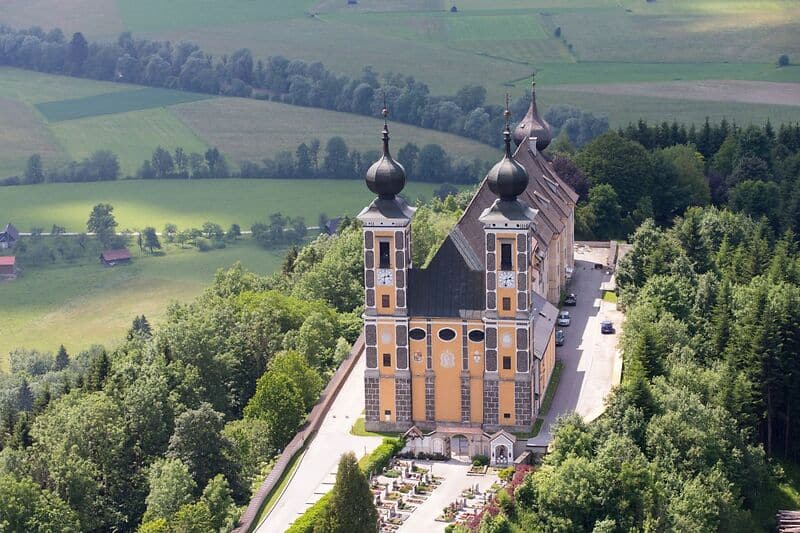
Organ and bells
Sie sind hier: Home > Parishes > Parish Frauenberg an der Enns > Organ and bells
Organ and bells
Here you will find some information about the organ and the bells of the parish church
The main organ in the west gallery of the pilgrimage church was built around 1687 and has a high baroque façade with three round towers and six Solomonic columns. Alluding to the nine muses, [...] nine sculptures playing music intonate the praise of God: the life-size depiction of King David with a harp leads an ensemble of eight angels playing music. They hold instruments in their hands, namely the trombone, bass gamba, cornett, lute, viola, trumpet and conductor's baton. Franz Xaver Krisman modified the organ around 1780, and in 1823 Simon Anton Hötzel added a second manual, the pipework for which he housed in an extension behind the organ. In 2013-2014, the instrument underwent an extensive restoration by organ builder Kögler, whereby a return to its Baroque state, which might have made sense from a conservation point of view, was avoided.
Since summer 2019, a mechanical organ by master organ builder Detlef Kleuker from the second half of the 20th century has stood on the south wall of the chancel. It was originally installed in the parish church of St Peter in Hüsten, in the municipality of Arnsberg in the German state of North Rhine-Westphalia. The simple case was adapted to the baroque church interior of Frauenberg.
Disposition (1 manual with attached pedal): Gedackt 8′, Rohrflöte 4′, Prinzipal 2′, Mixtur 2f.1′.

The Frauenberg parish and pilgrimage church has a melodious, ten-part chime, the largest set of bells in Styria. The expansion of the original five-part peal became necessary as the Gothic "Maria Schutz Bell" was reinstalled in the belfry of the north tower in autumn 2016 after decades. The resulting sound gap was closed by casting two more bells. In 2017, a bell was cast for the "Intercession Chapel" in the garden, which is part of the church's peal of bells. In 2018, the "Linzer bell" was cast to round off the exterior renovation of the church.
Frauenberg now has two sets of bells with different sounds: The original five-part main peal and a five-part secondary peal. The full peal of all bells can only be heard on the highest holidays, as these are two sets of bells with different sounds.
Main bells: Bells 1-5 Secondary bells: Bells 5-10
1st bell: Jubilee bell, "Joachim and Anna", Perner 2004, 1,700 kg, tone d1
2nd bell: "Herz Jesu", St Florian 1950, 964 kg, tone f1
3rd bell: Angelus bell, "Maria Himmelfahrt", St Florian 1950, 500 kg, tone a1
4th bell: death bell, "Josef", St Florian 1950, 300 kg, tone c2
5th bell: Consecration bell, "Bonifatius u. Adalbertus", St Florian 1950, 224 kg, tone d2
6th bell: Bell of mercy, "Maximilian von Lorch u. Hedwig von Andechs", Eifeler Glockengießerei (D) 2016, 120 kg, tone f2
7th bell: Jägerstätter bell, "Franz Jägerstätter u. Erzengel Gabriel", Eifeler Glockengießerei (D) 2016, 90 kg, tone g2
8th bell: Maria Schutz-Glocke, "Schutzmantelmadonna u. Apostel Andreas", Hans Mitter (Judenburg) 1449, 90 kg, tone b2
9th bell: Linz bell, "Florian von Lorch and Severin von Noricum", Perner 2018, 80 kg, tone c3
10th bell: Intercession bell, "Benedict of Nursia", Grassmayr 2017, 25 kg, tone d3
Bell 8 rings daily at 8 pm in remembrance of the "Holy Year of Mercy 2016". The latter bears an image of St Hedwig of Andechs, depicting the miraculous image in the Hedwigsbründl, which is located in the home town of the current Superior of Frauenberg, Fr Maximilian Schiefermüller OSB, in Bad Zell in Upper Austria. These two bells are the first works of the Eifel bell foundry in Austria. The Linzer bell was donated by pilgrims from the diocese of Linz due to the centuries-long connection and as thanks to Our Lady of Frauenberg.